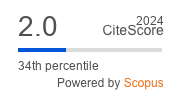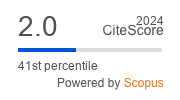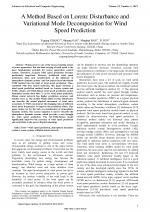| 2/2019 - 1 | View TOC | « Previous Article | Next Article » |
A Method Based on Lorenz Disturbance and Variational Mode Decomposition for Wind Speed PredictionZHANG, Y. |
| Extra paper information in |
| Click to see author's profile in |
| Download PDF |
Author keywords
wind speed prediction, atmospheric dynamics system, Lorenz system, artificial neural network
References keywords
wind(27), speed(22), energy(18), forecasting(16), model(13), prediction(11), neural(11), novel(8), systems(7), renewable(7)
Blue keywords are present in both the references section and the paper title.
About this article
Date of Publication: 2019-05-31
Volume 19, Issue 2, Year 2019, On page(s): 3 - 12
ISSN: 1582-7445, e-ISSN: 1844-7600
Digital Object Identifier: 10.4316/AECE.2019.02001
Web of Science Accession Number: 000475806300001
SCOPUS ID: 85066296866
Abstract
Wind power is one of the most promising means of power generation. But the time-varying of wind speed is the most fundamental problem for power generation control system. Therefore, accurate wind speed prediction becomes particularly important. However, traditional wind speed predictions often lack consideration of the influence of atmospheric dynamic system. And few papers have introduced VMD method into the field of wind speed prediction. Thus, combined with four neural networks, this paper develops a wind speed prediction method based on Lorenz system and VMD, obtains LD-VMD-Elman wind speed prediction model. Simulation results show that: 1) As for wind speed prediction, Elman neural network has higher prediction accuracy and smaller error. 2) The models which added Lorenz disturbance can describe the actual physical movement of wind more accurately. 3) VMD can abstract the changing rules of different wind speed frequencies to improve the prediction effect. This paper makes up for the lack of consideration of atmospheric dynamic system. The Lorenz equation is used to describe the atmospheric dynamic system, which provides a new thought for wind speed prediction. The LD-VMD-Elman model significantly improves the accuracy of wind speed prediction and contribute to the power dispatch planning. |
| References | | | Cited By «-- Click to see who has cited this paper |
| [1] E. Ssekulima, M. B. Anwar, A. A. Hinai, M. S. Elmoursi, "Wind speed and solar irradiance forecasting techniques for enhanced renewable energy integration with the grid: a review," IET Renewable Power Generation, vol. 10, no. 7, pp. 885-898, 2016. [CrossRef] [SCOPUS Times Cited 182] [2] J. Zhao, Y. L. Guo, X. Xiao, J. Z. Wang, D. Z. Chi, Z. H. Guo, "Multi-step wind speed and power forecasts based on a WRF simulation and an optimized association method," Applied Energy, vol. 197, pp. 183-202, 2017. [CrossRef] [SCOPUS Times Cited 136] [3] W. Y. Y. Cheng, Y. B. Liu, Y. W. Liu, Y. X. Zhang, W. R. Mahoney, T. T. Warner, "The impact of model physics on numerical wind forecasts," Renewable Energy, vol. 55, pp. 347-356, 2013. [CrossRef] [SCOPUS Times Cited 46] [4] J. Zhao, Z. H. Guo, Z. Y. Su, Z. Y. Zhao, X. Xiao, F. Liu, "An improved multi-step forecasting model based on WRF ensembles and creative fuzzy systems for wind speed," Applied Energy, vol. 162, pp. 808-82, 2016. [CrossRef] [SCOPUS Times Cited 258] [5] Y. G. Zhang, Y. Zhao, G. F. Pan, J. F. Zhang, "Wind speed interval prediction based on Lorenz disturbance distribution," IEEE Transactions on Sustainable Energy, [CrossRef] [SCOPUS Times Cited 54] [6] E. Erdem, J. Shi, "ARMA based approaches for forecasting the tuple of wind speed and direction," Applied Energy, vol. 88, pp. 1405-1414, 2011. [CrossRef] [SCOPUS Times Cited 831] [7] J. Bessac, E. Mihai Constantinescu, M. Anitescu, "Stochastic simulation of predictive space-time scenarios of wind speed using observations and physical models," Annals of Applied Statistics, vol. 12, no.1, pp. 432-45, 2018. [CrossRef] [SCOPUS Times Cited 12] [8] P. Ramasamy, S. S. Chandel, A. K. Yadav, "Wind speed prediction in the mountainous region of India using an artificial neural network model," Renewable Energy, vol. 80, pp. 338-347, 2015. [CrossRef] [SCOPUS Times Cited 151] [9] G. Song, Q. Dai, "A novel double deep ELMs ensemble system for time series forecasting," Knowledge-Based Systems, vol. 134, pp. 31-49, 2017. [CrossRef] [SCOPUS Times Cited 71] [10] H. Liu, H. Q. Tian, X. F. Liang, Y. F. Li, "Wind speed forecasting approach using secondary composition algorithm and Elman neural networks," Applied Energy, vol. 157, pp. 183-194, 2015. [CrossRef] [SCOPUS Times Cited 284] [11] Z. S. Yang, J. Wang, "A hybrid forecasting approach applied in wind speed forecasting based on a data processing strategy and an optimized artificial intelligence algorithm," Energy, vol. 160, pp. 87-100, 2018. [CrossRef] [SCOPUS Times Cited 91] [12] J. Z. Wang, S. H. Xiong, "A hybrid forecasting model based on outlier detection and fuzzy time series - A case study on Hainan wind farm of China," Energy, vol. 76, pp. 526-541, 2014. [CrossRef] [SCOPUS Times Cited 63] [13] O. Karakus, E. E. Kuruoglu, M. A. Altinkaya, "One-day ahead wind speed/power prediction based on polynomial autoregressive model," IET Renewable Power Generation, vol. 11, no. 11, pp. 1430-1439, 2017. [CrossRef] [SCOPUS Times Cited 119] [14] Y. G. Zhang, B. Chen, G. F. Pan, Y. Zhao, "A novel hybrid model based on VMD-WT and PCA-BP-RBF neural network for short-term wind speed forecasting," Energy Conversion and Management, vol. 195, pp. 180-197, 2019. [CrossRef] [SCOPUS Times Cited 226] [15] Q. H. Hu, S. G. Zhang, M. Yu, Z. X. Xie, "Short-term wind speed or power forecasting with heteroscedastic support vector regression," IEEE Transactions on Sustainable Energy, vol.7, pp. 241-249, 2016. [CrossRef] [SCOPUS Times Cited 153] [16] X. B. Kong, X. J. Liu, R. F. Shi, K. Y. Lee, "Wind speed prediction using reduced support vector machines with feature selection," Neurocomputing, vol. 169, pp. 449-456, Dec. 2015. [CrossRef] [SCOPUS Times Cited 162] [17] Y. Ren, P. N. Suganthan, N. Srikanth, "A novel empirical mode decomposition with support vector regression for wind speed forecasting," IEEE Transactions on Neural Networks and Learning Systems, vol. 27, no. 8, pp. 1793-1798, 2016. [CrossRef] [SCOPUS Times Cited 189] [18] C. J. Yu, Y. L. Li, Y. L. Bao, H. J. Tang, G. H. Zhai, "A novel framework for wind speed prediction based on recurrent neural networks and support vector machine," Energy Conversion and Management, vol. 178, pp. 137-145, 2018. [CrossRef] [SCOPUS Times Cited 169] [19] P. Jiang, Y. Wang, J. Z. Wang, "Short-term wind speed forecasting using a hybrid model," Energy, vol. 119, pp. 561-577, 2017. [CrossRef] [SCOPUS Times Cited 123] [20] Y. G. Zhang, C. H. Zhang, S. Gao, P. H. Wang, F. L. Xie, P. L. Cheng, S. Lei, "Wind speed prediction using wavelet decomposition based on Lorenz disturbance model," IETE Journal of Research. [CrossRef] [SCOPUS Times Cited 12] [21] Y. H. Chen, Z. S. He, Z. H. Shang, C. H. Li, L. Li, M. L. Xu, "A novel combined model based on echo state network for multi-step ahead wind speed forecasting: A case study of NREL," Energy Conversion and Management, vol. 179, pp. 13-29, 2019. [CrossRef] [SCOPUS Times Cited 69] [22] C. J. Huang, P. H. Kuo, "A Short-term wind speed forecasting model by using artificial neural networks with stochastic optimization for renewable energy systems," Energies, vol. 11, no. 10, 2018. [CrossRef] [SCOPUS Times Cited 83] [23] Y. G. Zhang, Y. Zhao, S. Gao, "A novel hybrid model for wind speed prediction based on VMD and neural network considering atmospheric uncertainties," IEEE Access. [CrossRef] [SCOPUS Times Cited 58] [24] Y. G. Zhang, P. H. Wang, T. Ni, P. L. Cheng, S. Lei. "Wind power prediction based on LS-SVM model with error correction," Advances in Electrical and Computer Engineering, vol. 17, pp.3-8, Jan. 2017. [CrossRef] [Full Text] [SCOPUS Times Cited 65] [25] L. L. Wang, X. Li, Y. L. Bai, "Short -term wind speed prediction using an extreme learning machine model with error correction," Energy Conversion and Management, vol. 162, pp. 239-250, 2018. [CrossRef] [SCOPUS Times Cited 148] [26] E. N. Lorenz, "Nondeterministic theories of climatic change," Quaternary Research, pp.495-506, 1976. [CrossRef] [SCOPUS Times Cited 100] [27] Y. G. Zhang, P. H. Wang, P. L. Cheng, S. Lei, "Wind speed prediction with wavelet time series based on Lorenz disturbance," Advances in Electrical and Computer Engineering, vol. 17, pp.107-114, 2017. [CrossRef] [Full Text] [SCOPUS Times Cited 28] [28] R. Ye, Q. Dai, "A novel transfer learning framework for time series forecasting," Knowledge-Based Systems, vol. 156, pp. 74-99, 2018. [CrossRef] [SCOPUS Times Cited 116] [29] J. Naik, S. Dash, P. K. Dash, R. Bisoi, "Short term wind power forecasting using hybrid variational mode decomposition and multi-kernel regularized pseudo inverse neural network," Renewable Energy, vol. 118, pp. 180 -212, 2018. [CrossRef] [SCOPUS Times Cited 106] [30] J. Medina, M. Ojeda-Aciego. "Multi-adjoint t-concept lattices," Information Sciences, vol. 180, no. 5, pp. 712-725, 2010. [CrossRef] [SCOPUS Times Cited 156] [31] C. Pozna, R. E. Precup, J. K. Tar, I. Skrjanc, S. Preitl, "New results in modelling derived from Bayesian filtering," Knowlege-Based Systems, vol. 23, no. 2, pp. 182-194, 2010. [CrossRef] [SCOPUS Times Cited 78] [32] J. Saadat, P. Moallem, H. Koofigar, "Training echo state neural network using harmony search algorithm," International Journal of Artificial Intelligence, vol. 15, no. 1, pp. 163-179, 2017. [33] J. Ruiz-Rangel, C. J. Hernandez, L. M. Gonzalez, D. J. Molinares, "ERNEAD: Training of artificial neural networks based on a genetic algorithm and finite automata theory," International Journal of Artificial Intelligence, vol. 16, no. 1, pp. 214-253, 2018. [34] A. Glowacz, "Acoustic-based fault diagnosis of commutator motor," Mechanical Systems and Signal Processing, vol. 7, no. 11, 2018. [CrossRef] [SCOPUS Times Cited 319] [35] A. Glowacz, "Fault diagnosis of single-phase induction motor based on acoustic signals," Electronics, vol. 117, pp. 65-80, 2019. [CrossRef] [SCOPUS Times Cited 67] [36] C. H. Yao, Q. Dai, G. Song, "Several Novel Dynamic Ensemble Selection Algorithms for Time Series Prediction," Neural Processing Letters, 2018. [CrossRef] [SCOPUS Times Cited 12] [37] K. Dragomiretskiy, D. Zosso, "Variational mode domposition," IEEE Transactions on Signal Processing, vol. 62, pp. 531-544, 2014. [CrossRef] [SCOPUS Times Cited 7677] [38] A. Glowacz, W. Glowacz, "Vibration-Based Fault Diagnosis of Commutator Motor," Shock and Vibration, 2018. [CrossRef] [SCOPUS Times Cited 63] [39] The Sotavento wind farm in Galicia, Spain, 2018. [Online] Available: Temporary on-line reference link removed - see the PDF document Web of Science® Citations for all references: 0 SCOPUS® Citations for all references: 12,477 TCR Web of Science® Average Citations per reference: 0 SCOPUS® Average Citations per reference: 312 ACR TCR = Total Citations for References / ACR = Average Citations per Reference We introduced in 2010 - for the first time in scientific publishing, the term "References Weight", as a quantitative indication of the quality ... Read more Citations for references updated on 2025-07-01 06:53 in 238 seconds. Note1: Web of Science® is a registered trademark of Clarivate Analytics. Note2: SCOPUS® is a registered trademark of Elsevier B.V. Disclaimer: All queries to the respective databases were made by using the DOI record of every reference (where available). Due to technical problems beyond our control, the information is not always accurate. Please use the CrossRef link to visit the respective publisher site. |
Faculty of Electrical Engineering and Computer Science
Stefan cel Mare University of Suceava, Romania
All rights reserved: Advances in Electrical and Computer Engineering is a registered trademark of the Stefan cel Mare University of Suceava. No part of this publication may be reproduced, stored in a retrieval system, photocopied, recorded or archived, without the written permission from the Editor. When authors submit their papers for publication, they agree that the copyright for their article be transferred to the Faculty of Electrical Engineering and Computer Science, Stefan cel Mare University of Suceava, Romania, if and only if the articles are accepted for publication. The copyright covers the exclusive rights to reproduce and distribute the article, including reprints and translations.
Permission for other use: The copyright owner's consent does not extend to copying for general distribution, for promotion, for creating new works, or for resale. Specific written permission must be obtained from the Editor for such copying. Direct linking to files hosted on this website is strictly prohibited.
Disclaimer: Whilst every effort is made by the publishers and editorial board to see that no inaccurate or misleading data, opinions or statements appear in this journal, they wish to make it clear that all information and opinions formulated in the articles, as well as linguistic accuracy, are the sole responsibility of the author.



